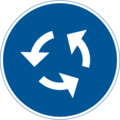Roundabouts
A roundabout is a type of circular intersection or junction in which road traffic is permitted to flow in one direction around a central island, and priority is typically given to traffic already in the junction.
Engineers use the term modern roundabout to refer to junctions installed after 1960 that incorporate various design rules to increase safety. Both modern and non-modern roundabouts, however, may bear street names or be identified colloquially by local names such as circle, road circle, traffic circle, rotary, rotunda or island.
Compared to stop signs, traffic signals, and earlier forms of roundabouts, modern roundabouts reduce the likelihood and severity of collisions greatly by reducing traffic speeds and minimizing T-bone and head-on collisions. Variations on the basic concept include integration with tram or train lines, two-way flow, higher speeds and many others.
Traffic exiting the roundabout comes from one direction, instead of three, simplifying the pedestrian's visual environment. Traffic moves slowly enough to allow visual engagement with pedestrians, encouraging deference towards them. Other benefits include reduced driver confusion associated with perpendicular junctions and reduced queuing associated with traffic lights. They allow U-turns within the normal flow of traffic, which often are not possible at other forms of junction. Moreover, since vehicles that run on gasoline averagely spend less time idling at roundabouts than at signalled intersections, using a roundabout potentially leads to less pollution. When entering vehicles only need to give way, they do not always perform a full stop; as a result, by keeping a part of their momentum, the engine will produce less work to regain the initial speed, resulting in lower emissions. Research has also shown that slow-moving traffic in roundabouts makes less noise than traffic that must stop and start, speed up and brake.
Modern roundabouts were first standardised in the UK in 1966 and were found to be a significant improvement over previous traffic circles and rotaries. Since then they have spread and modern roundabouts are commonplace throughout the world.[1]
